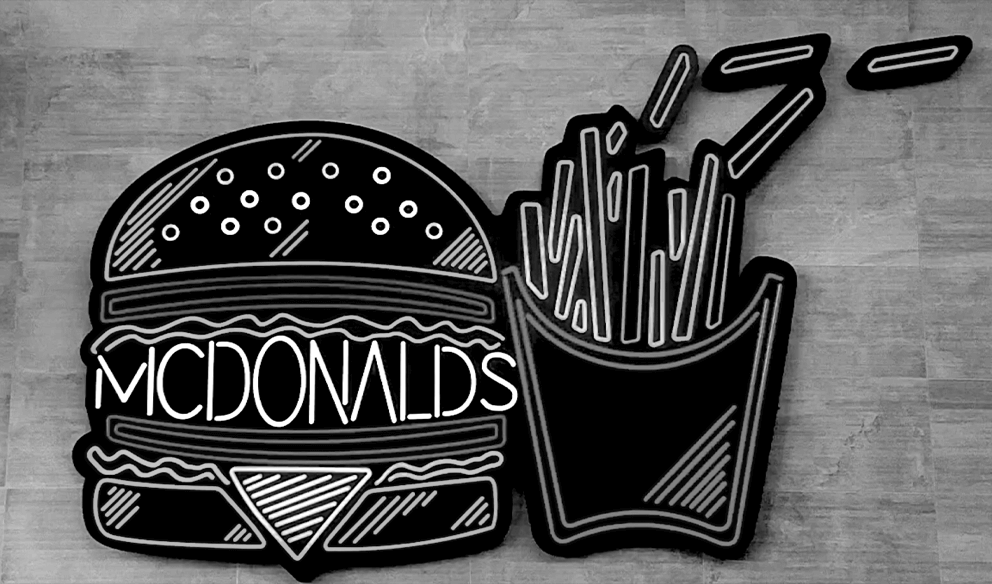Every patty is pressed, weighted to the milligram, measured to the millimeter, and cooked to 155C in 38 seconds. Moments later, it is slid between two buns and ready to be served. Any employee with even the most basic training knows how to manage the process. “Welcome to McDonald’s, can I take your order?
Today, this assembly line seems simple and easy to replicate. Yet this systematic control is what kept McDonald’s at the top of the global fast-food chain for decades.
Exploitation
The 1970s to 1990s marked an era of organizational optimization, led by major players like McDonald’s. Their competitive edge? Offering increased quantity by decreasing costs as much as possible. In other words, the focus turned to ramping up optimization and exploitation on site. For McDonald’s, this meant keeping the recipe for their flagship product—the Big Mac—as is while speeding up the preparation process (to exactly 38 seconds) and drastically diminishing the cost of raw materials. This principle now applies to every process in all fast-food chains, from training to franchises. There is no room for improvisation.
This trend significantly influenced consumers and the economy. Supply chains gained an exceptional level of efficiency, which lead to globalization, and there was an increase in purchasing power for consumers thanks to the price drop in goods.
It’s no wonder, then, that optimization became a key goal of all successful managers for 30 years. Academia also followed suit, creating management models geared towards exploitation and training future exploiters.
This was not without its share of consequences. Although competitive advantages changed once again during the 2000s, today many management schools continue to base their teachings on outdated models. Which means they’re training new managers who find themselves having to adapt to a whole new model management model: exploration.
Exploration
Michael Porter—author of numerous popular exploitation models in the 1980s—spoke about how competitive advantages had changed in a paper he wrote in 2001. Although we’ve spent decades transforming everything into a commodity and creating price wars, a company’s new competitive advantage is its ability to innovate. That means we must now explore new paradoxes in our environment in order to uncover business opportunities.
In their 2004 book Blue Ocean Strategy, Chan Kim and Renée Mauborgne said as much: You can’t create a “blue ocean” without exploring beyond your “red ocean.”
Organizations unable to find the balance between exploitation and exploration in an environment that was perpetually changing suddenly found themselves trying to further optimize and exploit processes that no one wanted on the market anymore. Such was the fate of many big brands of the day, from Kodak to Blockbuster, Nokia, Motorola, and more.
Québec didn’t emerge unscathed—and neither, I’m sure, did your organization. Unfortunately, those who never find the right balance will likely see their company suffer and profits plummet without ever fully understanding why.
On the other hand, companies who quickly found their balance remained at the top of their game. When competition grew increasingly fierce and consumers lost their taste for Big Macs—whose recipe had never changed—McDonald’s opted to revamp their menu. More burger options, salads, an all-day breakfast menu, smoothies, coffee, online sales, and much more are now the order of the day.
Balance
Here are a few key points to help you find the balance between exploitation and exploration in your organization:
Training. First and foremost, your managers are trained to be exploiters, not explorers. To find your balance, you need to remove them from their comfort zones and invest massively in various forms of training, starting with organizational design, design thinking, and creativity.
Culture change. A manager unused to exploring will leave little room for new ideas and be uncomfortable with failure. But exploration goes hand in hand with trial and error and, inevitably, some failure. If failure is not an option for your teams, there will never be space for exploration.
Agility. Before a manager can integrate a new idea into a company’s traditional processes, or try a new hypothesis, they must first implement a large control structure. This will inevitably make validating the idea more complex and increase costs—making a potential failure that much more painful. That’s why your organization must set up a way to test ideas at little cost, using a kind of “Fail fast, learn fast” approach.
Room for strategic reflection. A good exploiter plans the future based on data and past results, while finding ways to optimize the process—all of which short circuits any strategic reflection. Rather, a company looking to the future should always leave room for strategic thought—from finding new paradoxes to developing new ideas—before rolling out their strategic plan.
If you’re still unsure, try starting with a simple Design Thinking workshop. You’ll be surprised at how far it can take you and what an energy boost it can be for your team.




















